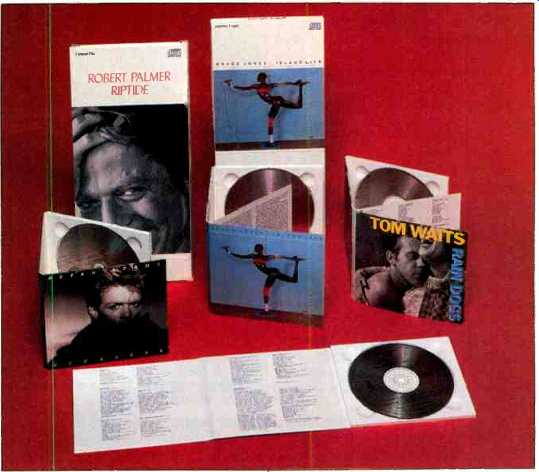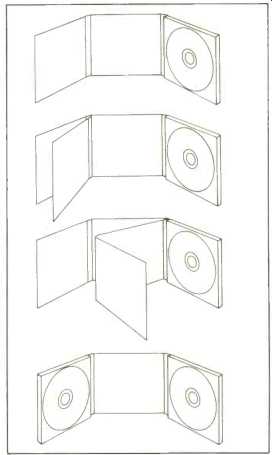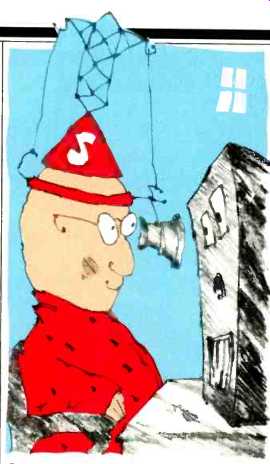DRESSED-UP DISCS

Fumble-Proof Packaging
I rather like a new Compact Disc packaging format-the Digi-Pak from AGI-that appears to me to offer a reasonable alternative to the Jewel Box. Now, while the Jewel Box is part of the CD Standard, there are Standards and there are standards. For example, the original Standard for the Compact Cassette, also a Philips development, specified the cassette box, and of course there are now a variety of other styles of boxes available, both in the aftermarket and as original packaging. This new Digi Pak is to be used by the record companies on an OEM basis, and it appears to offer certain advantages.
I don't know how many times you've dropped a Jewel Box and broken a hinge, but I've got about 15% of my collection of CDs suffering from this seemingly congenital malady--fumblitis Editorius. I think, however, that the ear on the lid or front of the box just isn't strongly enough made to stand up to the wear and tear it will take in the normal course of its life. I've asked several of my CD-maker contacts about replacement lids, and a couple of them have promised me a handful.
I'm still waiting. I'd even buy a few dozen at, say, 500 each, but I can't find anyone who sells them-mail order or otherwise. If anyone decides to go into this business, I'll take a bunch of lids as my fee for use of the idea.

Anyway, the Digi-Pack does away with this problem. Basically, it's made up of a revised center insert, of plastic, shaped much like the one inside the Jewel Box, with a wraparound of cardboard to carry the graphics. The insert is not exactly like the Jewel Box's. For one thing, it's easier to get the CD off the center spindle of the Digi-Pak because its four corners have ramps arranged so that it is easy to get a finger under the CD. Pressure at two points-up at the ramp, and down at the spindle pops the CD out of the Digi-Pak.
It's also easier to get to the CD. I need two hands to open the Jewel Box; I can open the Digi-Pak with one. Who cares? Someone trying to get at a CD to play it while driving a car, for instance.
You can see in the drawings that there are several configurations AGI can supply; we've seen only the simpler, single -disc styles so far, a few from Island Records and one from A&M. The half -dozen I've had my hands on look better to me than the Jewel Box. Which is to say, in university terms, that their graphical achievement quotient is relatively superior. ("What?") Also, to look at the album -cover graphics, you don't have to peer through the plastic lid of the Jewel Box.
My contact at AGI is chary about answering my "How much?" question directly, and I think he's right to point out that the two forms of packaging aren't directly comparable. And he needs an answer to "For how many?" before he can answer my question on price. The different formats cost different prices too. The upshot of this is that using a Digi-Pak won't cause a CD manufacturer to suddenly have to raise prices by $5-or enable him to lower prices by that much.
My guess is that you'll be seeing more of these in the record stores, from several more labels than Island, A&M, Capitol, and American Gramaphone, the only firms said to be testing the packaging at this time. -E.P.
Demos de Mode

We editors use specific recordings, other than the ones we normally listen to for pleasure, to wring out loudspeaker systems during our travails at shows and press functions.
At Audio, we also use these discs to separate the sleepers from the goats amongst the speakers herded in for review. This latter hurdle is a go/no go or pass/fail test where units submitted for potential review get two chances to sound acceptably good.
We presently use CDs, rather than LPs, because of their ease of handling and repeatedly clean signal--the last pass is as good as the first, providing our ears are up to it. I might add that we are still searching for a truly good piano run, preferably at high level, but with enough notes to have fundamentals in the ranges of all three drivers in a three-way system. If anyone knows of such, please write to us in care of the magazine.
Though we would not pretend that the following are the only discs which might be employed for these purposes, here are some we do use:
Opus 3 Test Record 1, Depth of Image (CD 7900). "Labyrinth" has a very nice male vocal, "Zamponas" switches from large panpipes to conversation and produces a startling sense of space, and Bach's "Invention No. 14" has four guitars arranged in a semicircle (at least on the better speakers). We're still getting to know Test Record 3, Dynamics, but it promises to be useful.
RCA's Transformer by Lou Reed (PCD14807) is a good example of how the transcription of old masters to CD can be worthwhile. The cut we use is "Walk on the Wild Side," specifically, the part where the girls come across the studio toward the open mikes. With some speakers, it sounds as if the distance they travel is upwards of 20 feet; with others, it sounds like only about five. On one system, they seem to jump at listeners from about 10 feet out, right up to the mikes. Thanks are due Randy Patton, now of Sumo; he played me this cut on the Ti series speakers from JBL, for whom he worked at the time.
Verve's We Get Requests by the Oscar Peterson Trio (810 047-2) is another example of how some of the older recordings do well in the transfer. We use the bowed and plucked bass on "You Look Good to Me" to check the low-end reproduction. It's recorded at a higher level than the piano, but it's naturally high, even though many speakers reproduce it at a lower level. One speaker seemed to fall off a cliff when bassist Ray Brown got halfway down his fingerboard.
GRP's Mountain Dance by Dave Grusin (GRP-D-9507) is something I first ran into on a JVC prerecorded metal tape. The master used for the CD has, I believe, had its balances altered from the running master used for the tape, but the title cut has a cymbal imaged so well I can almost count the rivets. There are some extreme transients here too, from the piano, which is very closely miked.
Indeed, some say it is too closely miked; I can only reply that I've heard some few speakers not go CrUnCh with this input. Also, "Thanksong" has my nomination for Sweetest Piano Ever Recorded and is rivaled, in my estimation, only by the "Three Cowboy Songs" cut on Sheffield's Discovered Again, also by Grusin.
Female vocals are tough for speakers to reproduce without coloration, and it amazes me how two different speakers--both good--can be so different in how they handle the ladies. The CD we use most often is Sheffield Lab's West of Oz by Amanda McBroom (CD-15), and then usually the "Dorothy" track. (Why did Dorothy leave Oz?) Two other discs of this same genre are Silver Linings:
Songs by Jerome Kern sung by Joan Morris (Arabesque Z6515) and Blue Skies, with Kiri Te Kanawa and Nelson Riddle and his orchestra ( London 414 666-2). These are relatively new additions to our library, but at present I think they will be permanent.
Male vocals, for some reason, are usually less difficult for speakers to reproduce, at least in my experience.
We use two CDs: Trouble in Paradise by Randy Newman (Warner Bros. 9 23755-2), with "The Blues" being the most played track, and "Der Doppelganger" sung by Shura Gehrman, with Nina Walker playing piano, on a Nimbus sampler (NIM 5001 1). There is a very wide dynamic range to Mr. Gehrman's voice on this recording, and some speakers go buzzy as a result.
One recording which received much attention in its LP version also deserves mention in CD: Cantate Domino on Proprius/AudioSource (CDP 7762), which we use less often than the others, mostly because of my musical tastes, but which is sweet and clean nonetheless.
The last disc, which fits into the The CD to Take When You Can Only Take One to the Show category, is the Denon Audio Technical CD (38C39 7147). The 99 tracks on this disc may be divided into two basic categories, music and test signals, with the latter further divided into general audio signals and special ones for CD players. There is a good variety of music, from jazz and rock to classical, with the emphasis on instrumental classical. The test signals in the basic section include tracks for channel identification, balance, and phase checks; there are white and pink noise tracks for measurement and setup. The signals in the CD test section are pretty specialized and are generally intended for measurements.
-E.P.
(adapted from Audio magazine, Jun. 1986; by IVAN BERGER)
= = = =